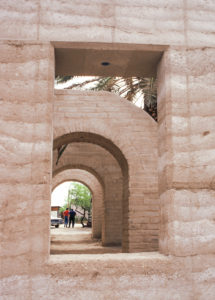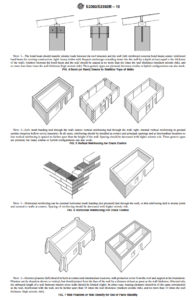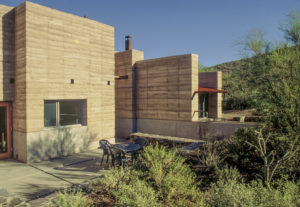This consensus standard was developed by an international task group to serve both U.S. and international needs for sound technical guidance for earthen wall systems, incorporating sustainable building and development goals, and including affordability and use by people of all economic circumstances. It has improved both building safety and recognition of the value of earthen construction internationally.
- Category
- Materials Structure
- Subcategory
- Earthen Wall System
- Adopted By
- ASTM International
- Applies To
- Projects using Earthen Walls; international
- Owned By
- ASTM International
- Managed By
- ASTM International Committee E60.01
- Participation
- Year of Adoption
- 2005
- Current Version
- 2010
- Update Cycle
- Recent Action
- 2010 addition of design appendix
- Code/Policy
| Policy Title | Purpose of Policy |
|---|---|
| ASTM E2392 Standard Guide for Design of Earthen Wall Building Systems | This accredited standard provides guidance for earthen building systems, addressing both technical requirements and considerations for sustainable development. Earthen building systems include adobe, rammed earth, cob, cast earth, and other earthen building technologies used as structural and non-structural wall systems. |
When ASTM International (formerly called the American Society for Testing and Materials) created the first subcommittee on sustainability for buildings, ASTM E6.71 (now E60.01) in 1998, the opportunity opened to develop a standard for earthen wall construction as a non-industrial, low environmental impact building material and system. The importance of being able to develop the standard in this subcommittee was that it would allow formal consideration of the sustainable aspects and economic accessibility along with the structural and other technical aspects. Once ASTM approved this activity within this subcommittee an international task group was formed, led by the Development Center for Appropriate Technology. Over several years the task group developed the first version of the standard, published in 2005 as ASTM E2392-05 Standard Guide for Design of Earthen Wall Building Systems. Subsequently, the Ecological Building Network updated the standard by adding substantial engineering guidance for seismic safety, as had only then come to light, included in a new appendix in the standard, “Empirical Design and Minimum Detailing Requirements for Earthen Structures.” The updated standard was published as ASTM E2392-10 in 2010. This Standard was developed by ASTM Committee E60.01.
Excerpts of the Scope from the standard:
1. Scope
1.1 This standard provides guidance for earthen building systems, also called earthen construction, and addresses both technical requirements and considerations for sustainable development. Earthen building systems include adobe, rammed earth, cob, cast earth, and other earthen building technologies used as structural and non-structural wall systems.
NOTE 1: Other earthen building systems not specifically described in these guidelines, as well as domed, vaulted, and arched earthen structures as are common in many areas, can also make use of these guidelines when consistent with successful local building traditions or engineering judgment.
5.3 Building Code Impact—Earthen building systems have historically not been engineered, but as of the late 20th Century it is for the first time in history possible to reliably apply rational structural design methods to earthen construction. A large number of earthen building codes, guidelines and standards have appeared around the world over the past few decades, based upon a considerable amount of research and field observations regarding the seismic, thermal and moisture durability performance of earthen structures. Some of those standards are:
- Australian Earth Building Handbook
- California Historical Building Code
- Chinese Building Standards
- Ecuadorian Earthen Building Standards
- German Earthen Building Standards
- Indian Earthen Building Standards
- International Building Code / provisions for adobe construction
- New Mexico Earthen Building Materials Code
- New Zealand Earthen Building Standards
- Peruvian Earthen Building Standards
This guide draws from those documents and the global experience to date in providing guidance on earthen construction to engineers, building officials, and regulatory agencies.
The standard is being used in a number of countries where it provides much needed basic design and construction guidance. One example is in Haiti where work continues to develop and build seismically safe and affordable housing and buildings, as documented in this article in ASTM’s Standardization News: “The Haiti Co-Laboratory Project”

This is a “standard guide” rather than a fully code-compliant technical standard. The intention when creating the standard was that it be compatible with codes and policies anywhere, maintaining flexibility for sound practice based on good engineering and design principles and local conditions and resources. In its current form, the standard uses what is known as “permissive” language rather than stating in mandatory language what “shall” be done or
adhered to, suggesting instead, what “should” be done. Building codes require clarity about what is or is not acceptable.
Because the current 2010 version of this standard is not written in mandatory language, it does not meet the International Code Council’s requirements for reference in their U.S.-based model building codes. This does not diminish the value and importance of the technical guidance offered, particularly in the appendix, “Empirical Design and Minimum Detailing Requirements for Earthen Structures,” added to the 2010 version. The appendix offers some of the most up-to-date technical information available—on earthen materials, mixing, workmanship, design, out-of-plane stability, top of wall stabilization, horizontal and vertical reinforcing, seismic considerations, and material tests—making it a valuable reference for projects seeking permits through the alternative materials, designs and methods of construction provisions in codes. There is interest in updating the standard and revising it to address this issue but that process has not yet been formally initiated as of early 2017.
| Development Center for Appropriate Technology Website | Ecological Building Network: BuildWell Source: Earth Materials |
| Article: “Code or Standard? What’s the difference between a code and a standard?” by Michael Heinsdorf, PE, Consulting – Specifying Engineer, 07/01/2015 |
The technical requirements of the standard include discussion of structural engineering design for both stabilized and unstabilized earth, mortars, durability, flood design issues, and design criteria guidance. The 2010 version of the standard includes an appendix: “Empirical Design and Minimum Detailing Requirements for Earthen Structures,” which introduced the most current information on materials, mixing, workmanship, design, out-of-plane stability, top of wall stabilization, horizontal and vertical reinforcing, seismic considerations, and material tests.
Excerpted from the Standard:
1.1.1 There are many decisions in the design and construction of a building that can contribute to the maintenance of ecosystem components and functions for future generations. One such decision is the selection of products for use in the building. This guide addresses sustainability issues related to the use of earthen wall building systems.
1.1.2 The considerations for sustainable development relative to earthen wall building systems are categorized as follows: materials (product feedstock), manufacturing process, operational performance (product installed), and indoor environmental quality (IEQ).
1.1.3 The technical requirements for earthen building systems are categorized as follows: design criteria, structural and non-structural systems, and structural and non-structural components.
The primary lesson from the process of developing this standard is the importance of understanding the requirements for a standard to be able to be referenced in U.S. model building codes. If the intention for a new or updated existing standard is to provide readily acceptable criteria and guidance for code approval, then the standard should be developed in mandatory, code-compliant language and address issues that will be directly relevant to obtaining permits and passing construction inspections.
A secondary lesson is the importance of including a broad array of stakeholders in the process, including representation by both public and private sector participants, and where appropriate, international experts and practitioners. Though this may involve greater time and expense in the development process, the benefits can be significant, such as introducing new research, improved practices, and broader perspectives on performance and context of use.
Finally, this standard provides an example of a pathway to develop technical guidance and criteria for public domain, non-proprietary, non-industrial building systems and technologies within the formal processes for developing consensus standards for construction in the U.S.
If sufficient support emerges, people worldwide would benefit from upgrading this “standard guide” to a full “technical standard” with the mandatory language that would allow it to be referenced in U.S. codes. Until such interest and support emerges, this standard will remain in its current version.
This standard, and the process used to develop it, remain a model for other non-industrial and/or non-proprietary building materials or systems in need of better, more widely available technical guidance. An additional benefit of the process is the value of bringing together diverse stakeholders with knowledge, practical expertise, and the need for a standard to broaden the base of information and practice on which to base a such a standard.

